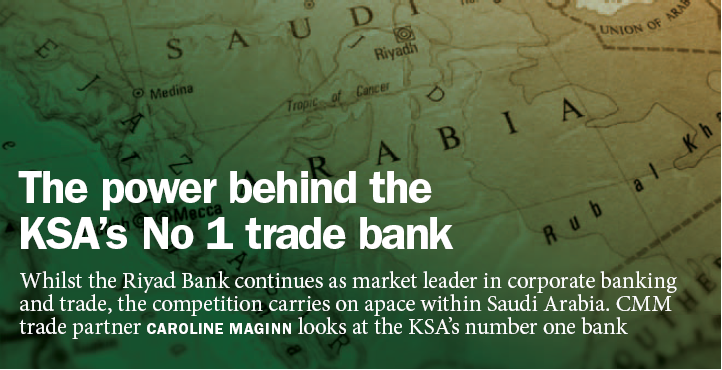Although the Middle East was not as badly aff ected by the global fi nancial crisis as the Western world, corporates across

the region are experiencing diffi culties when it comes to accessing bank fi nance. LIZ SALECKA explains why.
While a traditionally conservative approach to both lending and borrowing – together with and a strong focus on satisfying regional needs – put many Middle Eastern banks in a good position to steer through the global downturn, the Dubai crisis of November 2008 led to uncertainty in both their local and regional fi nancial markets.
“Companies in the region face a number of key issues such as finding liquidity in the currency they need, and the fact that a lot of banks have become more circumspect about their exposures,” says Farooq Siddiqi, head of transaction banking for MENA at Standard Chartered Bank.
He explains that many banks have now taken a more cautious approach to lending because they grew very quickly before 2008, and then realised that this growth was not sustainable.
“Local banks, particularly in the UAE, have among the highest asset to deposit ratios – and they want to manage this downwards. Th ese banks are only as strong as their clients, and, as a result, are looking very carefully at the companies they are prepared to expose themselves to.”
More tightening ahead
According to Ricky Th irion, vice-president, treasury, Etihad Airways, credit tightening by banks has been generally

greater than anticipated across the Middle East, and corporates have also witnessed a major rise in the cost of funding.
“There are much tighter controls around credit risk, which was much looser in many institutions before the fi nancial crisis than it should have been,” he says.
“The fl ow of capital through the market is still constrained by tighter credit risk regimes and liquidity is still not eff ectively reaching the ordinary corporate or retail customer.”
The implementation of Basel III, which will require banks to increase their Tier 1 capital ratios from two per cent to seven per cent, is expected to lead to even greater tightening.
“Capital is much scarcer, and, with Basel III coming in, banks are facing a tighter capital regime, which some are already preparing for, and this will place limitations on the liquidity they can provide,” explains Andrew McMichael, group treasurer at logistics company Agility in Kuwait.
Need for finance
In spite of this, economic growth in the Middle East is being buoyed on by international trade and huge investment in infrastructure projects – both of which have increased the need for bank finance.
“This year, we have seen increased activity in payments and trade fl ows right across the region. Despite the downturn of 2008/9, business has remained fairly buoyant, and this is certainly a region which is suff ering less than others as a result of the crisis,” says Dominic Broom, managing director, BNY Mellon Treasury Services, who describes the Gulf as a global centre of commerce.
“In Dubai, certain sectors, such as construction remain well below prior peaks and a lot of projects have been put on hold or postponed, but eff orts to diversify the economy into areas such as logistics and fi nancial services are looking good, and we (as a bank) are growing our business there.”

Broom explains that in certain countries, such as Lebanon, the UAE and Jordan, which have a strong history of cross-border trading, a large number of trading companies need fi nancing support from local institutions.
“There is also growing demand for fi nance in countries such as Saudi Arabia, whose economies are growing and where governments are investing in major new infrastructure such as railway and airport projects,” he adds.
Funding diversity required
Many large Middle Eastern corporates, faced with tighter credit controls, also now recognise a growing need to fi nd additional and back-up sources of funding.
Thirion believes that in the past many Middle Eastern companies relied on too few fi nance providers, but notes that achieving diversity in bank funding is not easy in today’s market.
“Many companies previously took their eye off the ball a bit in terms of the diversity of their funding sources, and they now need to move quickly and diversify,” he says.
“However, this may not be the best time to do this as banks have refocused towards satisfying the needs of their key customers and have, in fact, been reducing their range of customers.”
He adds that larger companies are hence now placing a stronger emphasis on raising fi nance in overseas debt capital markets.
“The debt capital markets represent a mediumterm solution,” adds McMichael, who notes that accessing overseas capital markets may prove a slow process for those corporates that still need to meet corporate governance and disclosure requirements to get a credit rating.
The alternative
Another option open to many Middle Eastern corporates is to maximise their own internal liquidity and enhance their working capital by taking advantage of structured finance solutions, such as trade finance.
“Over the last two years, we have seen corporates deleveraging their balance sheets as short-term credit lines have not been as readily available as was historically the case,” explains Broom. “Corporates have, therefore, needed to fi nd alternative sources of cash and, as such, they are looking at better managing their working capital.”
While many global banks with an established presence in the region such as hSBC, Standard Chartered Bank and JPMorgan actively off er transaction banking services and packaged structured fi nance solutions to corporates, some local banks, particularly in the UAE such as Emirates Bank NBD and Mashreq Bank, have also taken major steps in this direction.
Emirates NBD Bank off ers domestic and international receivables fi nancing services, collection services and credit protection, as well as bespoke trade solutions, which include pre- and post-shipment fi nance. Mashreq Bank, meanwhile, off ers import and export fi nancing as well as working capital fi nancing and receivables fi nancing.
Broom believes that despite their past conservatism, many other regional and local banks are now preparing to follow suit and move into the provision of enhanced transaction banking services and structured fi nance.
“There is a risk that people could revert to unsecured short-term lending. however, despite their more costly and more involved structures, both trade fi nance and supply chain fi nance do off er a number of benefi ts from a business management and transaction capability perspective,” he says.
“What has happened here now is that many fi nancial institutions have re-found the zeal to continue down the same path as they followed before, and transaction banking is a core part of that off ering.”
He points out that BNY Mellon, “as a bankers’ bank”, is looking to assist both local and regional banks in their quest to off er alternative fi nance solutions.
“Most of our work is with local and regional banks and we see this as a prime market as many of them do not have access to the global networks and solution capabilities that we can off er them,” he says.
“We have had discussions with local banks right across the region about the provision of global transaction banking services. Leading Saudi commercial banks such as National Commercial Bank also now have trade fi nance and transaction banking as part of their core off ering.”
The region’s growing emphasis on Islamic fi nancing structures bodes well for the future provision of structured fi nance across the region, according to Broom.
“Islamic financing structures lend themselves well to fi nancing trade fl ows. Cross-border trade is a core underlying commercial business that can be fi nanced using Islamic techniques,” he says.
Both local and regional banks are also well placed to succeed in the provision of alternative fi nancing, given the long and established relationships that they already have with corporate customers, which are considered crucial to business aff airs across the region. Local banks also benefi t from a more indepth understanding of their corporate customers’ businesses as well as their creditworthiness.
“There is a much more conservative approach taken by both corporates and banks to borrowing/ lending in the Middle East, and banks need to allow a considerable period of time to forge and develop local relationships,” says Broom, who believes that banks are currently placing increased focus on core client relationships. “There is a privileging of relationships – not necessarily fewer relationships.”
He adds, “Th ere is a gradual shift towards focusing on what the end- user customer’s needs are. Corporates are looking for end-to-end service delivery, and local banks can draw on partners for assistance. Where a bank can say to a customer that it has a relationship in a particular market it can make a stronger case for considering its services.”
Corporates in the region also believe that structured fi nance could present an alternative to traditional bank fi nance.
“We are in a good position, whereby our current fi nancing needs are relatively modest and, therefore, we do not need to go beyond traditional means of fi nance at this time,” says McMichael, but he also notes, “Trade finance has a close link with underlying cashfl ows, which gives increased comfort to banks and can put treasurers in a better position to resolve cashfl ow problems.”
 Cash And Trade Magazine For Cash and Trade professionals in the Middle East
Cash And Trade Magazine For Cash and Trade professionals in the Middle East



